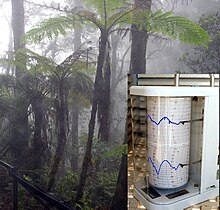This article has multiple issues. Please help improve it or discuss these issues on the talk page. (Learn how and when to remove these messages)
|

| Humidity and hygrometry |
|---|
 |
| Specific concepts |
| General concepts |
| Measures and instruments |
The wet-bulb temperature (WBT) is a temperature that can be measured by a thermometer covered in cloth which has been soaked in water at ambient temperature (a wet-bulb thermometer) and over which air is passed.[1] At 100% relative humidity, the wet-bulb temperature is equal to the air temperature (dry-bulb temperature); at lower humidity the wet-bulb temperature is lower than dry-bulb temperature because of evaporative cooling.
The wet-bulb temperature is defined as the temperature of a parcel of air cooled to saturation (100% relative humidity) by the evaporation of water into it, with the latent heat supplied by the parcel.[2] A wet-bulb thermometer indicates a temperature close to the true (thermodynamic) wet-bulb temperature. The wet-bulb temperature is the lowest temperature that can be reached under current ambient conditions by the evaporation of water only.
Even heat-adapted people cannot carry out normal outdoor activities past a wet-bulb temperature of 32 °C (90 °F), equivalent to a heat index of 55 °C (131 °F). A reading of 35 °C (95 °F) – equivalent to a heat index of 71 °C (160 °F) – is considered the theoretical human survivability limit for up to six hours of exposure.[3][4]
- ^ Guy W. Gupton (2002). HVAC Controls: Operation & Maintenance. The Fairmont Press, Inc. pp. 288–. ISBN 978-0-88173-394-5.
- ^ A Dictionary of Weather. Oxford Reference. 2008. ISBN 978-0-19-954144-7.
- ^ "Potentially fatal combinations of humidity and heat are emerging across the globe".
- ^ Buis, Alan. "Too Hot to Handle: How Climate Change May Make Some Places Too Hot to Live". Climate Change: Vital Signs of the Planet.